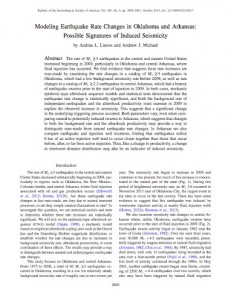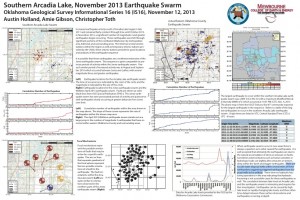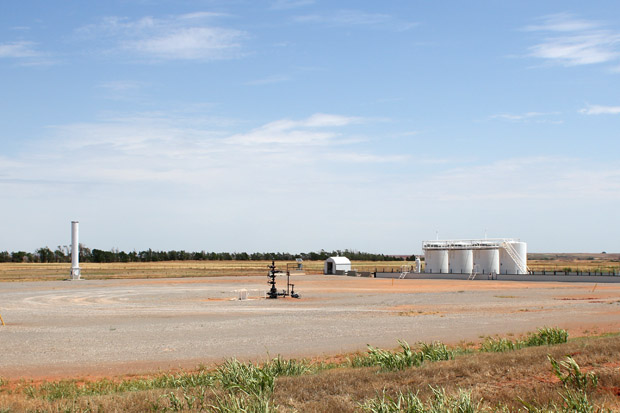Oklahomans Live With Shaking as Researchers Study Earthquake Swarm
-
Joe Wertz

Joe Wertz / StateImpact Oklahoma
Amanda and Keith Erwin, of Edmond, say they're learning to live with near-daily earthquakes. The Erwins have written letters to both of their state lawmakers asking them to investigate.
Keith Erwin says they remind him of the artillery he used to hear growing up near the Fort Sill Army base in Lawton. His wife Amanda says the earthquakes sound like thunder.
“The chandelier was swinging, and the walls were rumbling, the bed was rumbling,” Amanda Erwin says.
That’s when the game starts.
“We just turn and look at each other … what do you think it was? A 2.5? Nah … that had to have been a 3.0,” Keith Erwin says.
I interviewed the Erwins in the living room of their impressive home in an upscale Edmond neighborhood. We talk about broken dishes at their neighbors’ house, quake-related cracks at their last home a few miles away, and how their children are a lot less scared than their parents.
And then a funny thing happens.
“Um… was that one just now,” Amanda Erwin asks. “Did you hear it? Did you hear that? A little rumble? OK, it might have been the workers.”
The Erwins are on edge, and they’re not alone.

Joe Wertz / StateImpact Oklahoma
Click here for StateImpact's interactive map of Oklahoma's 2009-2013 earthquake "swarm."
Shaky Feeling
Central Oklahoma is in the middle of an earthquake swarm, which started in 2009. The temblors are concentrated east of Oklahoma City, near Jones and Luther, and Prague, the site the 5.7-magnitude quake — the state’s largest — that injured two and damaged more than a dozen homes in 2011.
Oklahoma has always been a seismically active state, but the recent increase in quakes of 3.0-magnitude or greater — the threshold at which they’re usually perceivable — in heavily populated areas has contributed to a considerable social buzz, which includes lively Facebook posts and Twitter comments.
Oklahoma City 911 dispatchers fielded more than 150 quake-related calls after a particularly active day on April 16, 2013, which peaked with a 4.4-magnitude tremor east of the metro near Wellston.
“I just felt a bomb or something,” one caller told a 911 dispatcher. Another caller was scared that her rattling windows were evidence that someone was trying to break into her home. Many callers were simply curious or unused to the sensation of shaking.
“I was just sitting looking at the ballgame and my butt started moving,” another caller exclaimed to a 911 dispatcher that day.

Seismological Society of America
Click here to read research by the U.S. Geological Survey's Andrea Llenos, which was published in October 2013's Bulletin of the Seismological Society of America.
Swarm Science
In October 2013, the U.S. Geological Survey warned the quakes are likely to continue and could get worse. In response, state Insurance Commissioner John Doak urged Oklahomans to buy earthquake insurance.
The likelihood of an earthquake in central-Oklahoma has increased by a factor of 10, says Bill Leith, the USGS’s senior science adviser for earthquake and geologic hazards.
“That doesn’t mean that there’s going to be a large earthquake tomorrow, or next month, or next year even. But those probabilities are up very substantially,” Leith says.
Leith says the earthquakes are likely linked to disposal wells used by the oil and gas industry to bury toxic drilling fluid deep underground, a suspicion that mirrors research by Katie Keranen, a seismologist at Cornell University. Keranen has written papers about the Prague quakes, and is working on one about the Jones swarm.
“We can show that it’s quite reasonable that water flowing from these wells is actually triggering these earthquakes,” Keranen says.
Other researchers have identified links between Oklahoma’s earthquakes and disposal wells, which is part of a phenomenon known as “induced seismicity.”
In a paper published in the October 2013 Bulletin of the Seismological Society of America, USGS seismologist Andrea Llenos concluded that earthquake swarms in Oklahoma and Arkansas were likely man-made.
“… the rate of small-to-moderate earth- quakes in Oklahoma and Arkansas changed significantly in 2009, and these changes do not seem to be due to random fluctuations in natural seismicity rates,” Llenos and co-author Andrew Michael wrote.

Oklahoma Geological Survey
Click here to read a .pdf of research on earthquakes near Arcadia by the Oklahoma Geological Survey's Austin Holland.
Natural Reaction
While Keranen, Leith, Llenos, and other seismologists say Oklahoma’s earthquakes are very likely connected to the wells, there’s no absolute proof. Austin Holland, the state’s official seismologist at the Oklahoma Geological Survey, thinks there might be a natural increase, too.
“There are no salt-water disposal wells within several miles of these earthquakes suggesting triggered earthquakes from disposal wells to be unlikely,” Holland wrote in a paper about earthquakes near Edmond and Arcadia. The OGS is also examining whether historically high water levels at Lake Arcadia might be contributing to the quakes.

Joe Wertz / StateImpact Oklahoma
A waste fluid disposal well in western Oklahoma.
Other states with potential disposal well earthquakes, like Colorado, Arkansas and Ohio, have responded to the risk with new rules or laws for drillers.
After an earthquake struck near the Texas border in September, the Oklahoma Corporation Commission — the state’s oil and gas regulator — ordered a disposal well operator to slow down, but that was unusual. The Commission is considering endorsing a set of voluntary guidelines — known as “best practices ” — for disposal well operators.
Quake Games
The earthquake Amanda Erwin thought she heard wasn’t real, though a 2.5-magnitude quake did rumble near her home a short time later.
“You feel like you’re playing Battleship,” Erwin says. “You look at the map, and you see these little pings of all the different places they hit.”
Erwin and her husband laugh, but they’re clearly anxious. The earthquake games are a distraction, but they don’t think the quakes are a joke. The Erwins have written letters to both their state lawmakers and asked them to investigate.
